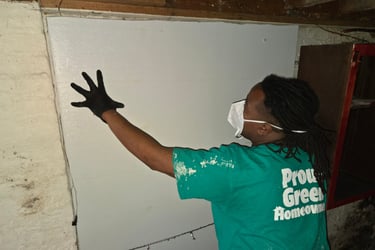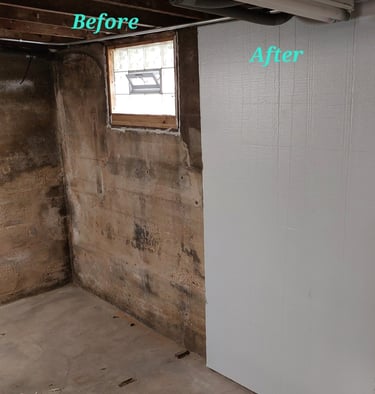Insulating Wall Boards: 15 Reasons Why
3/20/20247 min read
Green Homeowners United wants to help you pay the upfront cost of upgrading your basement to expand living space, fight climate change and save on energy bills!


Green Homeowners United worker preparing to put up an Insulating Wall Board in a basement
Where is the biggest loss of heat in most homes in Wisconsin? We at Green Homeowners United have done a LOT of energy assessments in homes all over the state, and on average the biggest source of heat loss is… the basement!
Most homes in Wisconsin don’t have finished basements, so you can already feel the temperature difference when you enter one. And while your attic may not have the fully recommended level of insulation (R-49+), it likely has at least some. Same with your above ground walls. Contrast that with basements, most of the time you can see that bare concrete. And despite its thickness, concrete's insulating “R-value” is generally less than most windows! AND the basement walls often have a greater square footage than all the windows in the house combined.
Here are 15 reasons why insulating your basement walls with Green Homeowners United’s special Insulating Wall Boards can make sense.
1. Your home will feel warmer
Not just your basement, but the whole home. Because of a phenomenon called “stack effect”, air moves around the home from the bottom up. So if the basement is colder, the rest of the house will feel it too. Insulating basement walls is like wearing socks, the whole body is warmer when the feet are covered!
2. Saves energy
The results of energy assessments, depending on our utility bills and how far it rises above ground, suggest that basement wall insulation can often see annual energy savings of 10%-30% of total house energy use! In fact, basement wall insulation has been found to be the number 1 largest collective utility bill saving potential for energy efficiency projects in Wisconsin homes! Even more than replacing bulbs with LEDs or installing smart thermostats.
3. Eligible for tax break
Did you know that from the 25c federal tax change, you can now get a $1,200 tax credit for adding Insulating Wall Boards to your basement? But that only counts for insulation, if you tried to drywall a basement wall you wouldn’t get a credit for that.
4. It isn’t affected by water
If your basement floods, say from a burst pipe, if your basement had fiberglass insulation and drywall, all of that would have to be ripped out and removed. But our Insulating Wall Boards are “hydrophobic”, meaning they won’t get wet. If water gets on them, they’ll just dry off.
5. They are a “vapor barrier”
Moisture is a problem in basements for a number of reasons. Concrete is porous, so vapor can get in most days. Research suggests basements can bring in as much as 15 gallons of water a day through vapor transmission! Additionally, through condensation. When warm inside air touches cold concrete walls, it can lead to moisture through condensation. How do you address that? Same as you would with a drink cozy during a hot summer day, you add foam insulation to it! And by putting these Insulating Wall Boards complete with an integrated vapor barrier and sealing the seams with airtight sealant you can stop that water vapor entry too! Listen to what one client of Green Homeowners United told Fox 6 news about how his basement didn’t have a moist damp smell after adding Insulating Wall Boards.
Note, major water leaks from damaged concrete walls should still be addressed through concrete repairs, generally from the exterior.
Wait! Why can’t I just use a plastic sheet for a vapor barrier?? - not only is a plastic sheet not insulating and thus not going to stop condensation, it often directly leads to biological growth (i.e. mold) through trapped moisture, AND it is explicitly NOT legal under Wisconsin’s energy building code SPS 322.38(4)
6. It is the starting point for finishing your basement
Finishing a basement can be a great way to increase living space and home value, and precursor to that is insulating the walls before or as part of finishing it! According to Cost vs Value report for the most recent available year, Milwaukee area homes on average see a $48,000 increase in home value at sale from a finished basement. Our Insulating Wall Boards can be drywalled over down the line, but they don’t have to be, because of the next benefit…
7. Our Insulating Wall Boards already count as a fire barrier
Do you know why you don’t see those pink boards of insulation in most people’s homes? Because rigid XPS or EPS foam board insulation is quite flammable, and it is against fire code to leave them exposed. Homeowners are required to cover rigid pink boards or spray foam insulation (except in rim joists) with an approved thermal barrier, such as drywall or equivalent. Our Insulating Wall Boards already count as a thermal barrier for fire code purposes, and can be left exposed.
8. Our Insulating Wall Boards can be made to look finished on their own already
Don’t want to drywall in a basement? Maybe because of the cost, the mess or because of the concern it might someday get wet? That’s ok, our Insulating Wall Boards themselves can be mudded/painted or covered with wall coverings for a more finished look! Add a textured paint/primer first with enough mil thickness and it would be difficult to differentiate it from drywall, without the concern of it ever getting damp. Or cover with wallpaper for a custom look.
Insulating Wall Board covered by a textured wall covering. Almost indistinguishable from drywall, without the moisture or mess concerns!
9. Stop air leaks and pest holes
One of the things we do at every home we put Insulating Wall Boards in is to also insulate and seal the “rim joists” aka “sill boxes” often with spray foam, where the concrete walls end and the floor joists sit on the walls, facing outside. This area is notorious for air leaks, especially around wires and pipes entering the home. And we cannot count how many times we’ve blocked mouse, bug or rat holes in basement rim joists in the process! Save energy, make the basement healthier.
10. Insulated basements are required for all homes built in Wisconsin today
Did you know that Wisconsin building code requires all homes built today to have insulated foundations? Whether from the inside or the outside, code officials know this step is vital, yet most of us live in homes built before 2000, so our homes weren’t built to the same standards. So if it makes so much sense that it is required in all new homes, shouldn’t we explore it in older ones?
11. It helps fight climate change at home
We already talked about how insulating basements saves energy, but that also means our homes aren’t using nearly the same amount of therms of natural gas or Kwhs of electricity to condition the living spaces. That means we are burning fewer fossil fuels, and thus reducing carbon emissions. All from home!
12. It helps make homes “heat pump ready”
Are you considering a “heat pump” to electrify your home to further reduce energy use by fully or partially getting off of natural gas or propane? Good thinking, but there are things we’d encourage first. An under-insulated, leaky home is going to take more energy to heat than it should, especially in winter when a heat pump has to work harder to heat. The more you insulate and seal, whether the basement or rest of the house, the most efficient your heat pump will be.
13. Research suggests insulated basement walls can prevent underground shifting
New research suggests that addressing underground heat leaking into the ground from boilers & furnaces through concrete, such as with insulation on basement walls, can slow what is called underground climate change, “...the phenomenon causes soil to expand and contract, which can vertically displace building foundations by as much as 12 millimeters and cause them to sink by as much as 8 millimeters, leading to potential cracks and corrosion”. While this study looked at commercial buildings in Chicago, the fundamental heat transfers of uninsulated basements in Wisconsin see similar effects at work.
14. Insulating Wall Boards can “enclose” lead paint on basement walls
An estimated 350,000 Wisconsin homes currently still have lead paint in them, and the often invisible dust can have substantial health risks, especially to children. Green Homeowners United is a lead-abatement certified firm, and we have received approval from WI Department of Health Service staff that our Insulating Wall Boards, properly sealed dust-tight at the edges, are allowable as a method of “enclosing” lead painted surfaces in basements. So if you are worried old paint on a basement wall might be lead-based, it is better to have the dust risk cleaned by professional abatement experts, and enclose the wall from generating more lead risk!
And finally…
15. Because we make it easy to afford to do the right thing! Let us pay for your upfront cost to add Insulating Wall Boards to your home!
For all these good reasons above, Green Homeowners United wants to help you afford these improvements. We can help you cover 100% of the upfront cost of the work, with 0% interest financing, so you can start the project now and space the costs out over time for up to 6 years, or make it part of a larger project such as including Energy-Star windows and attic insulation to make the home as energy efficient as possible now! Pay over time for the improvements that pay for themselves over time. Start fighting climate change at home today.


Get Your Home's Basement Upgraded for $0 upfront, and 0% interest to Start Saving Energy and Increase Home Value today!
Click here to schedule a phone call with Green Homeowners United to discuss any aspect of Insulating Wall Boards, and to learn more about what we shared above
--
Kevin Kane (he/him), Chief Economist


Insulating wall board before wall covering applied
Address
9618 W Greenfield Ave
West Allis, WI 53214
Appointment recommended
Contact
414-604-6450
info@GreenHomeownersUnited.com


